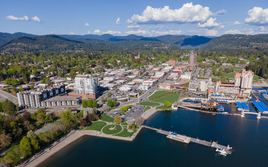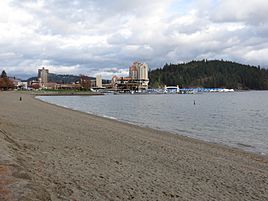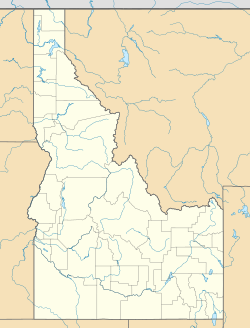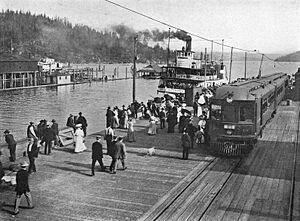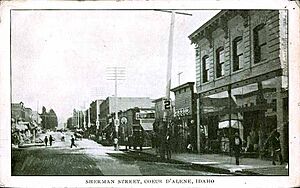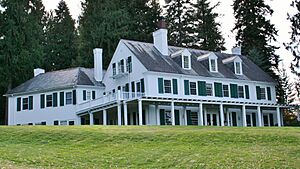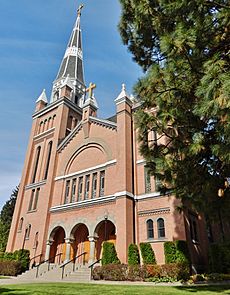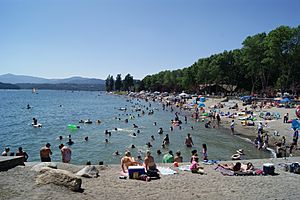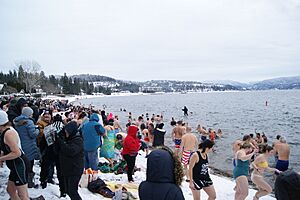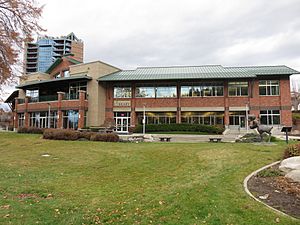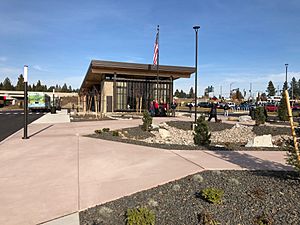Coeur d'Alene, Idaho facts for kids
Quick facts for kids
Coeur d'Alene
|
|||
|---|---|---|---|
|
Aerial view of Coeur d'Alene
Coeur d'Alene Resort and marina
Floating boardwalk
Independence Point
Coeur d'Alene Resort floating green
Coeur d'Alene and Tubbs Hill from City Park and Beach
|
|||
|
|||
| Nickname(s):
Lake City; CDA
|
|||
| Motto(s):
City with a Heart
|
|||
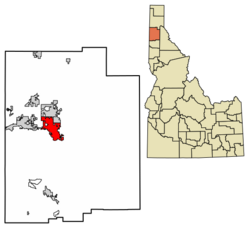
Location of Coeur d'Alene in Kootenai County, Idaho
|
|||
| Country | United States | ||
| State | Idaho | ||
| County | Kootenai | ||
| Founded | 1878 | ||
| Incorporated (town) | August 22, 1887 | ||
| Incorporated (city) | September 4, 1906 | ||
| Area | |||
| • City | 16.82 sq mi (43.56 km2) | ||
| • Land | 16.06 sq mi (41.58 km2) | ||
| • Water | 0.76 sq mi (1.98 km2) | ||
| Elevation | 2,247 ft (685 m) | ||
| Population
(2020)
|
|||
| • City | 54,628 | ||
| • Estimate
(2022)
|
56,733 | ||
| • Rank | US: 702nd ID: 7th |
||
| • Density | 3,522.0/sq mi (1,360.0/km2) | ||
| • Urban | 121,831 (US: 272nd) | ||
| • Metro | 183,578 (US: 240th) | ||
| • Combined | 781,497 (US: 70th) | ||
| Time zone | UTC–8 (Pacific (PST)) | ||
| • Summer (DST) | UTC–7 (PDT) | ||
| ZIP Codes |
83814, 83815
|
||
| Area code(s) | 208 and 986 | ||
| FIPS code | 16-16750 | ||
| GNIS feature ID | 2410187 | ||
Coeur d'Alene (pronounced "KOR duh-LAYN") is a city in Idaho, USA. It is the main city in northern Idaho and the county seat of Kootenai County. In 2020, about 54,628 people lived there.
The city is located on the north shore of Lake Coeur d'Alene, which is about 25 miles (40 km) long. It's also west of the Coeur d'Alene Mountains. People often call it the "Lake City" or simply "CDA."
The city gets its name from the Coeur d'Alene people, a Native American tribe. They have lived along the rivers and lakes of this area for a very long time. They were hunter-gatherers, meaning they hunted, fished, and gathered plants for food.
Coeur d'Alene started as a fort town in 1878, built by General William Tecumseh Sherman. Miners and prospectors came to the area when gold and silver were discovered nearby. The Northern Pacific Railroad arrived in 1883, helping the town grow. Later, the discovery of valuable white pine trees led to a big timber (logging) boom. The city officially became a city on September 4, 1906.
After the Great Depression, tourism became very important. Today, tourism is a huge part of the local economy. The Coeur d'Alene Resort is a famous spot with a long floating boardwalk. Tubbs Hill is a beautiful natural area in the city. There are also popular parks like City Park and McEuen Park. Coeur d'Alene is known for its golf courses, including one with a unique floating green. Nearby attractions include the Silverwood Theme Park, the largest theme park in the Northwestern United States. The city also hosts a popular Ironman Triathlon event.
Contents
History of Coeur d'Alene
The Coeur d'Alene people called themselves Schitsu'umsh, which means "those who are found here." They lived across a large area from eastern Washington to Montana. These Native Americans were skilled hunter-gatherers. They moved their villages to find food like wild game, fish (especially during salmon runs), and berries.
Early Explorers and Treaties
In 1807, fur trader David Thompson explored the area. He called the tribe "Pointed Hearts" and the lake "Pointed Heart Lake." It's thought that French-speaking guides might have given them the name "Coeur d'Alene," meaning "heart of an awl" (a sharp tool). This might have meant the tribal traders were very smart business people.
In 1846, the Oregon Treaty gave the United States control over the land where Idaho is now. Later, the U.S. government tried to move Native American tribes onto reservation lands. This made the Coeur d'Alene people upset because their land was getting smaller. These disagreements led to some fighting between the tribes and settlers. The Coeur d'Alene Reservation is now located south of the city.
In 1859, John Mullan built the 611-mile (983 km) Mullan Road. This road helped connect the Columbia River to the Missouri River, making it easier for people to travel.
Fort and Mining Boom
When gold was discovered in the western United States, more settlers came to the region. In 1878, General William Tecumseh Sherman ordered a fort to be built on the lake. It was first called Fort Coeur d'Alene, but later changed to Fort Sherman to honor the general. This fort gave the city its name.
Miners and prospectors arrived when gold and silver were found in the nearby mountains. The Northern Pacific Railroad reached the village in 1883. Coeur d'Alene became a place where ore from the mines was loaded onto trains after being brought by steamboats from the Coeur d'Alene River. The town officially became a town on August 22, 1887.
In the 1890s, there were some big disagreements between miners and mine owners in the Coeur d'Alene Mining District. Workers felt they were paid too little for risky jobs. These disagreements led to strikes and some destruction. The government had to send troops to restore order.
Timber and Tourism Growth
Around the 1890s, people discovered huge amounts of valuable white pine trees in northern Idaho. This led to a big timber industry boom. Many lumber companies moved in, building mills and creating jobs. This helped Coeur d'Alene grow a lot. The city officially became a city on September 4, 1906. By 1908, it was the county seat.
The timber industry grew even more with cars and chainsaws. By 1925, there were seven lumber mills in the area. However, during the Great Depression in the 1930s, the demand for lumber dropped. Many workers lost their jobs. Despite this, the city still saw some good things happen. Coeur d'Alene Junior College (now North Idaho College) started in 1933. A popular amusement park called Playfair Pier opened in 1942.
Because of its beautiful lake, tourism has always been important. In the early 1900s, people from Spokane would visit the park, shop, and take steamboat cruises. Magazines even called Coeur d'Alene a "wonderland." Tourism really took off in the 1950s and 1960s when new highways were built. The city started promoting itself as a great place to visit.
In the 1980s, tourism became the main focus of the local economy. New attractions like the Wild Waters water park (1982) and the Coeur d'Alene Resort (1986) were built. The resort, with its tall building and floating boardwalk, became very famous.
Around this time, a white supremacist group called the Aryan Nations moved into the area. However, the community of Coeur d'Alene stood up against their message. In 1986, the city received the Raoul Wallenberg Award for peacefully opposing the group. Coeur d'Alene also won the All-America City Award in 1990. The Aryan Nations group eventually went out of business in 2000.
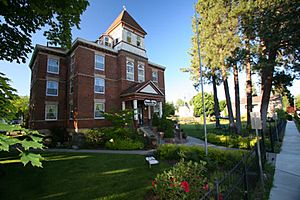
In the 1990s, Coeur d'Alene grew a lot. Many people moved there from other western states. The nearby Silverwood Theme Park also grew, adding new roller coasters and a water park. This brought even more tourists to the area.
Coeur d'Alene Today
In 2014, McEuen Park downtown was updated. It became a modern park with playgrounds and sports areas. Idaho is one of the fastest-growing states, and Coeur d'Alene has seen many new residents. People move here for a lower cost of living, more affordable homes, and an outdoor lifestyle.
Geography and Nature

Coeur d'Alene is about 30 miles (48 km) east of Spokane, Washington. The city covers about 16 square miles (41 square km), with most of it being land and a small part water.
Lakes and Mountains
The city sits on the north shore of Lake Coeur d'Alene. This lake is 25 miles (40 km) long and 1 to 3 miles (1.6 to 4.8 km) wide. It is fed by the Coeur d'Alene River and Saint Joe River. The lake levels are controlled by the Post Falls Dam on the Spokane River.
Near Coeur d'Alene, you'll find other beautiful lakes like Fernan Lake and Hayden Lake. Further north is Lake Pend Oreille, one of the largest and deepest natural lakes in the western United States. These lakes were formed by huge floods called the Missoula Floods thousands of years ago.
To the east of the city are the Coeur d'Alene Mountains, which are part of the Bitterroot Range. These mountains reach up to 7,352 feet (2,241 meters) high.
Forests and Wildlife
The forests east of the city are part of the Idaho Panhandle National Forests. These thick forests have ancient western redcedar trees. They are home to over 300 types of wildlife, including woodland caribou, Canada lynx, grizzly bear, and wolves.
The large lakes in Idaho attract many birds, especially bald eagles. From November to February, bald eagles come to Lake Coeur d'Alene to feed on salmon. The Cougar Bay Nature Preserve is a great place to watch wildlife near downtown.
Some environmental concerns exist due to past mining in the Silver Valley. The Coeur d'Alene Basin, including the lake, has some pollution from heavy metals like lead. Health officials advise people to wash anything that touches the soil or dust in the river basin.
Beautiful Scenery
Climate and Weather

Coeur d'Alene has cold, wet winters and warm, dry summers. The average temperature in January is about 31°F (–0.6°C), and in July, it's about 70°F (21.1°C). Temperatures can go above 90°F (32°C) about 18 days a year.
Northern Idaho gets more rain and snow than eastern Washington. This is because it's on the side of the Rocky Mountains that faces the ocean winds. The average yearly rainfall is 25 inches (64 cm), and the average snowfall is 46 inches (117 cm). The large lakes, like Lake Coeur d'Alene, help keep the nights milder and days cooler.
| Climate data for Coeur d'Alene, Idaho (1991–2020 normals, extremes 1895-present) | |||||||||||||
|---|---|---|---|---|---|---|---|---|---|---|---|---|---|
| Month | Jan | Feb | Mar | Apr | May | Jun | Jul | Aug | Sep | Oct | Nov | Dec | Year |
| Record high °F (°C) | 60 (16) |
62 (17) |
73 (23) |
94 (34) |
98 (37) |
108 (42) |
108 (42) |
109 (43) |
102 (39) |
88 (31) |
71 (22) |
60 (16) |
109 (43) |
| Mean maximum °F (°C) | 49.4 (9.7) |
51.3 (10.7) |
62.7 (17.1) |
74.0 (23.3) |
83.6 (28.7) |
88.5 (31.4) |
96.1 (35.6) |
96.3 (35.7) |
89.1 (31.7) |
74.9 (23.8) |
58.4 (14.7) |
49.2 (9.6) |
97.7 (36.5) |
| Mean daily maximum °F (°C) | 36.2 (2.3) |
40.7 (4.8) |
48.4 (9.1) |
56.2 (13.4) |
65.8 (18.8) |
72.1 (22.3) |
82.8 (28.2) |
83.0 (28.3) |
73.7 (23.2) |
58.4 (14.7) |
44.2 (6.8) |
36.1 (2.3) |
58.1 (14.5) |
| Daily mean °F (°C) | 31.2 (−0.4) |
33.6 (0.9) |
39.5 (4.2) |
46.4 (8.0) |
55.1 (12.8) |
61.5 (16.4) |
70.1 (21.2) |
69.5 (20.8) |
61.0 (16.1) |
48.6 (9.2) |
37.9 (3.3) |
31.2 (−0.4) |
48.8 (9.3) |
| Mean daily minimum °F (°C) | 26.2 (−3.2) |
26.5 (−3.1) |
30.7 (−0.7) |
36.7 (2.6) |
44.3 (6.8) |
50.9 (10.5) |
57.3 (14.1) |
56.0 (13.3) |
48.3 (9.1) |
38.7 (3.7) |
31.6 (−0.2) |
26.3 (−3.2) |
39.5 (4.2) |
| Mean minimum °F (°C) | 10.8 (−11.8) |
13.5 (−10.3) |
19.0 (−7.2) |
27.7 (−2.4) |
33.3 (0.7) |
42.1 (5.6) |
48.1 (8.9) |
47.0 (8.3) |
37.6 (3.1) |
26.3 (−3.2) |
19.7 (−6.8) |
12.8 (−10.7) |
4.6 (−15.2) |
| Record low °F (°C) | −30 (−34) |
−27 (−33) |
−13 (−25) |
5 (−15) |
21 (−6) |
28 (−2) |
36 (2) |
32 (0) |
17 (−8) |
2 (−17) |
−13 (−25) |
−26 (−32) |
−30 (−34) |
| Average precipitation inches (mm) | 3.21 (82) |
2.11 (54) |
2.68 (68) |
1.91 (49) |
2.14 (54) |
2.17 (55) |
0.73 (19) |
0.77 (20) |
0.81 (21) |
2.02 (51) |
3.34 (85) |
3.47 (88) |
25.36 (644) |
| Average snowfall inches (cm) | 10.0 (25) |
4.1 (10) |
2.2 (5.6) |
0.1 (0.25) |
0.0 (0.0) |
0.0 (0.0) |
0.0 (0.0) |
0.0 (0.0) |
0.0 (0.0) |
0.2 (0.51) |
2.1 (5.3) |
9.3 (24) |
28.0 (71) |
| Average precipitation days (≥ 0.01 in) | 14.4 | 11.1 | 12.6 | 11.3 | 11.1 | 9.1 | 3.8 | 3.5 | 6.0 | 11.1 | 14.8 | 13.2 | 122.0 |
| Average snowy days (≥ 0.1 in) | 4.5 | 2.3 | 1.3 | 0.2 | 0.0 | 0.0 | 0.0 | 0.0 | 0.0 | 0.0 | 1.3 | 4.4 | 14.1 |
| Source: NOAA | |||||||||||||
City Layout
Main Areas
Coeur d'Alene has grown into several neighborhoods. The downtown area is in the southeast, limited by lakes and mountains. Historic areas from the early 1900s are close to the city center.
The largest building in the city is the 216-foot (66 m) Coeur d'Alene Resort Lake Tower, located downtown. Because the city is growing fast, more apartments and condos are being built downtown.
Post Falls is Kootenai County's second-largest city. It has grown a lot with new stores and is a "bedroom community" for Spokane (meaning many people live there but work in Spokane). The historic Post Falls Dam and Falls Park are important local spots.
Hayden is the third-largest city in the area. It's known for Hayden Lake, which has many summer cabins and large homes. The Hayden Lake Country Club was built in 1907 and brought many tourists.
People and Community
| Historical population | |||
|---|---|---|---|
| Census | Pop. | %± | |
| 1890 | 491 | — | |
| 1900 | 508 | 3.5% | |
| 1910 | 7,291 | 1,335.2% | |
| 1920 | 6,447 | −11.6% | |
| 1930 | 8,297 | 28.7% | |
| 1940 | 10,049 | 21.1% | |
| 1950 | 12,198 | 21.4% | |
| 1960 | 14,291 | 17.2% | |
| 1970 | 16,228 | 13.6% | |
| 1980 | 19,913 | 22.7% | |
| 1990 | 24,563 | 23.4% | |
| 2000 | 34,514 | 40.5% | |
| 2010 | 44,137 | 27.9% | |
| 2020 | 54,628 | 23.8% | |
| 2022 (est.) | 56,733 | 28.5% | |
| U.S. Decennial Census 2020 Census |
|||
Population Facts
In 2020, Coeur d'Alene had 54,628 people and 22,699 households. The wider area, including Kootenai County, is part of a larger statistical area with Spokane, Washington. This combined area had over 745,000 people in 2020.
Most residents (93.8%) are White. About 4.3% of the population is Hispanic or Latino. The average age in the city is 35.4 years. Many new residents are retirees, meaning the number of people aged 65 and older has doubled since 2001.
Religion in Coeur d'Alene
Many people in Coeur d'Alene identify as Evangelical Protestant or Catholic. Idaho is part of a region known for lower rates of religious participation. However, the evangelical Christian community in Coeur d'Alene has been growing.
Economy and Jobs
Historically, Coeur d'Alene's economy was based on mining and logging. But since the 1940s, tourism has become the main focus. The city is now a big tourist spot, especially for water sports on the lake. People enjoy wake boarding, paddleboarding, sailing, fishing, and more.
Major Attractions and Businesses
Besides the lake, there are two main resorts: the Coeur d'Alene Resort and the WorldMark Arrow Point resort. The Coeur d'Alene Casino is nearby, and Silverwood Theme Park is the largest theme park in the Northwest. There are also three major ski resorts within a short drive. Tourism and hospitality jobs employ over 10,000 people in northern Idaho.
Coeur d'Alene is also a center for healthcare, education, media, manufacturing, and retail in northern Idaho. The Silver Lake Mall is the largest mall in the area. The Village at Riverstone has a park, movie theater, restaurants, and shops.
Some companies have their main offices in Coeur d'Alene, like Hecla Mining (a mining company) and the U.S. operations of Pita Pit (a restaurant chain). Buck Knives, a famous knife maker, moved its factory to nearby Post Falls in 2005. Rocky Mountain Construction, which builds roller coasters, is based in Hayden.
The average time people spend commuting to work is about 18.5 minutes. Many people also commute to Washington state for work.
Arts and Fun Activities
Coeur d'Alene has a growing arts scene. You can find a symphony orchestra and theater shows. The city has several art galleries, mostly in the downtown area along Sherman Avenue. The city also sets aside money to fund public art projects.
Music and Theater
The Coeur d'Alene Symphony started as a college class in the 1970s. They perform a free concert every Labor Day in City Park. You can also find street artists and musicians performing downtown. For theater, there's the Coeur d'Alene Summer Theatre and the Lake City Playhouse. The main places for performances are the Schuler Performing Arts Center and the Kroc Center.
Museums to Explore
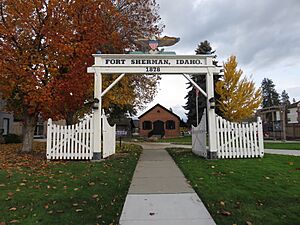
The Museum of North Idaho in downtown Coeur d'Alene tells the story of the region. It opened in 1973. Exhibits include "Schitsu'umsh," about the Coeur d'Alene people, and "The Mullan Road," about Idaho's first road. You can also see artifacts from the steamboats that used to travel the lake. The museum offers walking tours of the Fort Sherman grounds. The Fort Sherman chapel is the oldest building in the city.
Events and Festivals
Many community events happen in Coeur d'Alene during the warm summer months, often by the lake.
- Fourth of July Festival: This big celebration includes a parade, food, crafts, carnival rides, and live music. Many people watch the fireworks over the waterfront.
- Holiday Light Show: Starting in late November, the city lights up with over 1.5 million bulbs. There's a parade and fireworks, and the resort offers "Journey to the North Pole" cruises.
- Polar Bear Plunge: Every year on January 1, brave people run into the cold waters of Lake Coeur d'Alene at Sanders Beach.
- Summer Arts and Food Festivals: In early August, three big events happen together: Art on the Green (arts and crafts), Street Fair (shopping), and Taste of Coeur d'Alene (food). About 60,000 people attend these events.
Sports and Recreation
Coeur d'Alene is a popular place for golf. There are five golf courses in the city and eight more nearby. The Coeur d'Alene Resort Golf Course is famous for its 14th hole, which has the world's only movable floating green. The Circling Raven Golf Club is also a great course at the Coeur d'Alene Casino resort.
The city hosts several sports events:
- Ironman Coeur d'Alene: This challenging Ironman Triathlon event includes a 2.4-mile (3.9 km) swim in Lake Coeur d'Alene, a 112-mile (180 km) bike ride, and a 26.2-mile (42.2 km) run.
- Coeur d'Fondo: A bike race ranging from 15 to 108 miles (24 to 174 km).
- Coeur d'Alene Crossing: A 2.4-mile (3.9 km) swimming challenge across the lake.
- Coeur d'Alene Marathon: An annual running event held in late May.
In high school sports, there's a big rivalry game called the "Fight for the Fish" between Coeur d'Alene High School and Lake City High School.
Parks and Outdoor Fun
The natural beauty of Coeur d'Alene is a major draw. The main parks and natural areas near downtown include Tubbs Hill, City Park and Beach, and McEuen Park.
- Tubbs Hill: This 120-acre (49 ha) park offers a rugged 2.2-mile (3.5 km) trail with amazing views of the lake and city. Some people even enjoy cliff jumping into the lake from spots in the park.
- City Park and Beach: This 17-acre (6.9 ha) park has a 16-acre (6.5 ha) beach, volleyball courts, basketball courts, picnic areas, and a playground.
- McEuen Park: This 22.5-acre (9.1 ha) park has a large playground, a climbing rock, a splash pad, tennis and basketball courts, and a dog park. It also has a big pavilion for events and a boat launch.
Other fun places include the Kroc Center, which has pools, a fitness center, and recreation areas. The North Idaho Centennial Trail also runs through the city, perfect for biking and walking.
Education in Coeur d'Alene
The city has two public libraries: the Coeur d'Alene Public Library downtown and the Lake City Public Library. Library services in the area started in 1904.
Schools and Colleges
The Coeur d'Alene School District serves about 11,000 students in 18 schools. This includes two main high schools (Coeur d'Alene High School and Lake City High School), middle schools, and elementary schools. Students can also take college classes while still in high school through North Idaho College and the University of Idaho. The district also has special schools focused on arts and humanities or STEM (Science, Technology, Engineering, and Math).
The district is the sixth-largest in Idaho. There are also charter schools and private schools, including religious schools.
For higher education, North Idaho College is a public community college founded in 1933. It has over 5,000 students. The University of Idaho also has a presence in Coeur d'Alene.
Media and News
Coeur d'Alene is part of the Spokane television and radio market. This means it receives broadcasts from Spokane. The city also has its own daily newspaper, the Coeur d'Alene Press, which covers local news in northern Idaho. It was founded in 1892.
City Services
Getting Around
In Coeur d'Alene, streets run north-south, and avenues run east-west. Major roads include Sherman Avenue, Harrison Avenue, and U.S. Route 95. The city is connected by Interstate 90 (I-90), a major highway that goes through the Rocky Mountains. The route of I-90 east of Coeur d'Alene is similar to the old Mullan Road, which was built in 1861.
Most people in Coeur d'Alene use cars to get around. Traffic can get busy on some highways, especially U.S. 95.
Public Transportation
Public transportation helped Coeur d'Alene grow as a tourist spot early on. In 1903, an electric train line connected Spokane to the city. Steamboats also carried people and goods on Lake Coeur d'Alene. These services lasted until the late 1930s.
Today, Citylink provides free public bus service in Kootenai County. Buses run every hour, seven days a week. They are wheelchair-friendly and can carry bicycles. There are four bus routes covering different parts of the city and nearby towns.
For longer trips, Jefferson Lines provides intercity bus service. Coeur d'Alene does not have a passenger train station. The closest Amtrak stations are in Spokane and Sandpoint.
Airports
The closest major airport is Spokane International Airport, about 40 miles (64 km) west in Spokane, Washington. The Coeur d'Alene Airport – Pappy Boyington Field (KCOE) is a smaller airport in Hayden, used for general aviation. It was built in 1942 as a training base during World War II. It's named after Gregory "Pappy" Boyington, a World War II flying ace from North Idaho.
Near the marina on Lake Coeur d'Alene is the Brooks Seaplane Base (S76). This base is used for seaplanes, often for tours of Lake Coeur d'Alene and Lake Pend Oreille.
City Utilities
The city of Coeur d'Alene handles billing for water, sewer, stormwater, street lighting, garbage, and recycling. Electricity is provided by Kootenai Electric Cooperative and Avista Utilities, which also provides natural gas. The city gets its water from the Spokane Valley–Rathdrum Prairie Aquifer. The Post Falls hydroelectric dam on the Spokane River, built in 1906, generates electricity.
Healthcare Services
Kootenai Health is the main medical center for Coeur d'Alene and northern Idaho. It's a 329-bed community hospital and the largest employer in Kootenai County. Coeur d'Alene also has a Veterans Affairs clinic for veterans. The Panhandle Health District provides public health programs for the five northernmost counties in Idaho.
Police Department
The Coeur d'Alene Police Department was started in 1887. It has 103 police officers. The department also has a program called Officers Without Legal Standing (OWLS). These are retired law enforcement officers, many from California, who volunteer to help.
Sister City
Coeur d'Alene has one sister city: Cranbrook, British Columbia in Canada.
Images for kids
See also
 In Spanish: Coeur d'Alene (ciudad) para niños
In Spanish: Coeur d'Alene (ciudad) para niños


